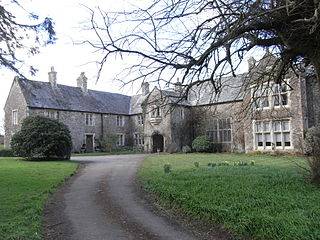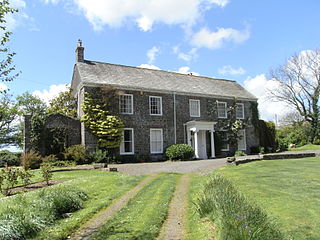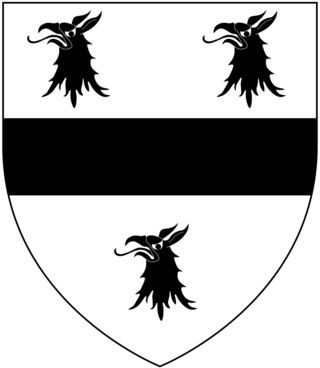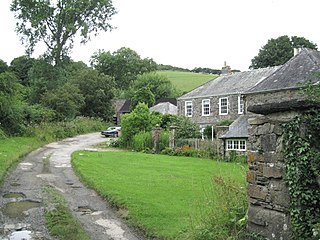Related Research Articles
William de Falaise, also called William of Falaise, was a Norman from Falaise, Duchy of Normandy, today in the Calvados department in the Lower Normandy region of north-western France. He became feudal baron of Stogursey in Somerset and also held manors in Devon.
The feudal barony of Berry Pomeroy was one of eight feudal baronies in Devonshire, England, which existed during the mediaeval era. It had its caput at the manor of Berry Pomeroy, 20 miles south of the City of Exeter and 2 miles east of the town of Totnes, where was situated Totnes Castle, the caput of the feudal barony of Totnes. The exact location of the 11th-century baron's residence is unclear; perhaps it was next to the parish church on the site of the former rectory known as Berry House, as it is now believed that the nearby ruined Berry Pomeroy Castle was not built until the 15th century.

The feudal barony of Bampton was one of eight feudal baronies in Devonshire which existed during the mediaeval era, and had its caput at Bampton Castle within the manor of Bampton.
The Manor of Shirwell was a manor in North Devon, England, centred on the village of Shirwell and largely co-terminous with the parish of Shirwell. It was for many centuries successively the seat of two of the leading families of North Devon, the Beaumonts and their heirs the Chichesters of Raleigh, Pilton, both of which families were seated at the estate of Youlston within the manor of Shirwell. The manor house which survives today known as Youlston Park is one of the most architecturally important historic houses in North Devon and exists largely in its Georgian form, but retains many impressive late 17th-century interiors.
East Hagginton was a historic estate within the manor and parish of Berrynarbor near to the coast of North Devon. It is near to, if not actually encompassing, the site of Watermouth Castle.

The feudal barony of Okehampton was a very large feudal barony, the largest mediaeval fiefdom in the county of Devon, England, whose caput was Okehampton Castle and manor. It was one of eight feudal baronies in Devonshire which existed during the mediaeval era.
Brictric was a powerful English thane whose many English landholdings, mostly in the West Country, are recorded in the Domesday Book of 1086.
The feudal barony of Gloucester or Honour of Gloucester was one of the largest of the mediaeval English feudal baronies in 1166, comprising 279 knight's fees, or manors. The constituent landholdings were spread over many counties. The location of the caput at Gloucester is not certain as Gloucester Castle appears to have been a royal castle, but it is known that the baronial court was held at Bristol in Gloucestershire.

The Domesday Book of 1086 lists in the following order the tenants-in-chief in Devonshire of King William the Conqueror:
William Cheever was one of the 52 Devon Domesday Book tenants-in-chief of King William the Conqueror. He held 46 landholdings in Devon. His lands later formed, the feudal barony of Bradninch, Devon. His brother was Ralph de Pomeroy, feudal baron of Berry Pomeroy, Devon, with whom several of his holdings had been divided into two parts, one for each brother. His sister was Beatrix, who held from him the manor of Southleigh.

The feudal barony of Plympton was a large feudal barony in the county of Devon, England, whose caput was Plympton Castle and manor, Plympton. It was one of eight feudal baronies in Devonshire which existed during the medieval era. It included the so-called Honour of Christchurch in Hampshire, which was not however technically a barony. The de Redvers family, first holders of the barony, were also Lords of the Isle of Wight, which lordship was not inherited by the Courtenays, as was the barony of Plympton, as it had been sold to the king by the last in the line Isabel de Redvers, 8th Countess of Devon (1237–1293).

Orleigh is a historic manor in the parish of Buckland Brewer, situated 4 miles to the south west of Bideford, North Devon, England. The manor house is known as Orleigh Court.

Thuborough in the parish of Sutcombe, Devon, England, is an historic estate, formerly a seat of a branch of the Prideaux family, also seated at Orcharton, Modbury; Adeston, Holbeton; Soldon, Holsworthy; Netherton, Farway; Ashburton; Nutwell, Woodbury; Ford Abbey, Thorncombe, all in Devon and at Prideaux Place, Padstow and Prideaux Castle, Luxulyan, in Cornwall. The present mansion house, comprising "Thuborough House" and "Thuborough Barton", the north-east block, is a grade II listed building.

Washfield is a village, parish and former manor in Mid Devon, Devon, England, situated about 2 miles north-west of Tiverton. The parish church is dedicated to St Mary the Virgin. It was within the jurisdiction of the historic West Budleigh Hundred. In 2001 the parish had a population of 362.

Orcheton is an historic estate in the parish of Modbury in Devon. The present house, known as Great Orcheton Farm is situated 1+1⁄2 miles south-west of Modbury Church.

Kenedon is an historic manor situated in the parish of Sherford in Devon.

Luscombe is an historic estate situated in the parish of Rattery in Devon.
The manor of Broad Hempston was a historic manor situated in Devon, England, about 4 miles north of Totnes. The present village known as Broadhempston was the chief settlement within the manor and remains the location of the ancient parish church of St Peter and St Paul.
The manor of Alverdiscott was a manor situated in north Devon, England, which included the village of Alverdiscott.

Weycroft is an historic manor in the parish of Axminster in Devon, England. The surviving manor house known as "Weycroft Hall" is a Grade I listed building which includes elements from the 15th, 16th and 17th centuries, with a great hall of circa 1400, and was restored in the 19th century.
References
- ↑ Sanders, p.106
- ↑ Thorn & Thorn, part 1, chap.34, 1-58
- ↑ Sanders, p.106, note 9
- ↑ Thorn & Thorn, part 2 (notes), chap.34
- ↑ Sanders, p.20; Thorn, part 2, chap.19
- ↑ Thorn & Thorn, part 2 (notes) chap.19
- ↑ Thorn & Thorn, Chap.19, 46, Beatrix is called "his sister" in the Exon Domesday in the holding of Southleigh
- ↑ Vivian, p.605
- ↑ 58 holdings listed in Domesday Book, listed in Thorne & Thorne, chapter 34, 1-58. "58 lordships in Devon" per Vivian, p.605
- ↑ Vivian, p.605
- ↑ Vivian, p.605
- ↑ Mériel, Amédée, Histoire de L'Abbaye Royale de Saint-Jean-de-Falaise, Ordre de Prémontrés, 2nd edition, Alençon, 1883, p.14
- ↑ Vivian, p.605